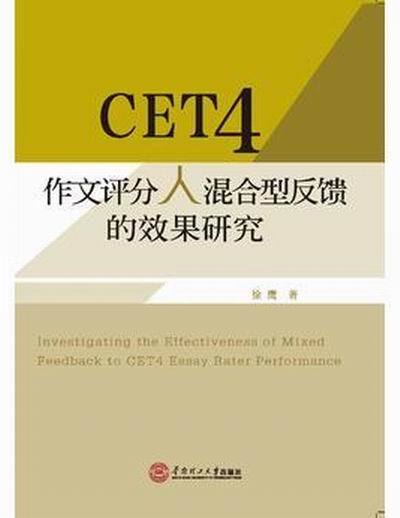《CET4作文評分人混合型反饋的效果研究》是2014年8月華南理工大學出版社出版的圖書,作者是徐鷹。
基本介紹
- 書名:CET4作文評分人混合型反饋的效果研究
- 作者:徐鷹
- 出版社:華南理工大學出版社
- 出版時間:2014年8月
- 頁數:240 頁
- 定價:40 元
- 開本:16 開
- 裝幀:平裝
- ISBN:9787562343608
- 責編:朱彩翩
內容簡介,圖書目錄,
內容簡介
本書分為三篇十章。第一篇:理論篇——主動發展教育理論對國小數學課堂教學的指引;第二篇:實踐篇——主動發展教育的理念在數學課堂教學中的實踐研究;第三篇:研讀篇——主動發展教育的理念對促進國小數學教師專業發展的作用。本書在編寫上達到了以下幾個特點:一是以學生為基本研究對象。主動發展的數學教育將學生納入研究的視野,而且對學生的研究達到了相當的深度和廣度,貫穿、滲透在教學實踐的全過程之中。因此,做到了在教學的每一個環節中,實現“以學生主動,健康發展為本”。二是方法論意識的凸顯。在現有的一些數學研究專著中,要么注重各種學科教學觀點和流派的介紹,要么關注教學策略、方法。
而本書的編寫力求做到將方法論意識滲透、貫穿在書中的各個角落,幫助教師明晰自己思考與實踐的基本立場、前提和視角,挖掘新的思維路徑,重組和豐富思維框架。主動發展的數學教育研究以促進生命的主動發展為基本立場和前提,形成教學價值觀、教學過程觀和教學評價觀。以此為基礎,在教學設計、教學過程等具體活動中反思和重建教師的思維方式,建立整體性、關係性和類型性思維方式,這就是方法論意識的具體體現。三是本土意識的強化。
圖書目錄
Chapter 1 Introduction
1.1 Background of the study
1.2 Purpose of the study and research questions
1.3 Significance of the study
1.3.1 Theoretical significance
1.3.2 Methodological significance
1.3.3 Practical significance
1.4 A note on terms
1.4.1 Mock essays
1.4.2 Rater effects/variability/biases/errors
1.4.3 Rating accuracy
1.4.4 Scoring/score validity
1.4.5 Scoring/rating expertise
1.4.6 Cognitive strategy
1.4.7 Meta-cognitive strategy
1.4.8 Rating session
1.4.9 Feedback iteration
1.4.10 Counter-balanced design
1.4.11 The correlation coefficient
1.4.12 The mixed feedback
1.5 The structure of chapters
Chapter 2 Literature review
2.1 Introduction
2.2 Rater variability as a serious threat to score validity in performance assessments
2.2.1 Models of performance assessment of writing
2.2.2 Factors that affect rater performance
2.2.3 Rater variability from the psychometric perspective
2.2.4 Rater variability from the hermeneutic perspective
2.2.5 Rater cognition studies
2.3 Rater training as a routine measure to control rater variability
2.3.1 Overview of procedures of rater training
2.3.2 Studies on rater training effectiveness
2.3.3 Critical issues in rater training
2.4 Rater feedback as an important part of training
2.4.1 Studies on rater feedback effectiveness
2.4.2 Some common problems
2.5 Methodological considerations
2.5.1 Content of the feedback
2.5.2 Delivery of the feedback
2.6 Summary
Chapter 3 Method
3.1 Introduction
3.2 Research Design
3.2.1 The mixed methods design of this study
3.2.2 The quasi-experimental nature of this study
3.2.3 Context of the study
3.2.4 Materials
3.2.5 Participants
3.2.6 Instruments
3.2.7 Pilot study
3.2.8 Procedures
3.3 Data analysis
3.3.1 MFRM analysis of ratings
3.3.2 Analysis of degree of certainty
3.3.3 Verbal protocol analysis
3.3.4 The questionnaire of raters' perceptions of mixed'feedback
3.3.5 The questionnaire of raters' evaluation of feedback effectiveness
3.3.6 Interview with those who are negative with the feedback effectiveness
3.4 Summary
Chapter 4 Results
4.1 Findings for Research Question 1 : The effect of the mixed feedback on rater variability
4.1.1 Findings for RQ1 ( 1 ) : The effect of the mixed feedback on rater severity
4.1.2 Findings for RQ1 (2) : The effect of the mixed feedback on rater internal consistency
4.1.3 Findings for RQ1 (3) : The effect of the mixed feedback on rater bias
4.1.4 Findings for RQ1 (4) : The effect of the mixed feedback on rater central tendency
4.1.5 Findings for RQ1 (5) : The effect of the mixed feedback on rater severity DRIFT
4.2 Findings for Research Question 2 : The extent to which EG raters can incorporate the mixed feedback into rating behavior when it is provided repeatedly over 3 iterations
4.2.1 First round results
4.2.2 Second round results
4.3 Findings for Research Question 3.The effect of the mixed feedback on raters' degree of certainty for their ratings
4.3.1 First round results
4.3.2 Second round results
4.4 Findings for Research Question 4.The effect of the mixed feedback on raters' decision.making
4.4.1 Findings for RQ4 ( 1 ) : The effect of the mixed feedback on raters' decision-making in terms of text features
4.4.2 Findings for RQ4 (2) : The effect of the mixed feedback on raters' decision-making in terms of information processing behaviors
4.5 Findings for Research Question 5 : Raters' perceptions of the mixed feedback ...
4.5.1 First round results
4.5.2 Second round results
4.6 Summary
Chapter 5 Discussion
5.1 Discussion of Research Question 1 : What effect does the mixed feedback have on rater variability7
5.1.1 Methodological considerations
5.1.2 Interpretation of the results
5.2 Discussion of Research Question 2.To what extent can EG raters incorporate the mixed feedback into rating behavior when it is provided repeatedly over 3 iterations7
5.2.1 Methodological considerations
5.2.2 Interpretation of the results
5.3 Discussion of Research Question 3: What effect does the mixed feedback have on raters' degree of certainty for their ratings7
5.3.1 Methodological considerations
5.3.2 Interpretation of the results
5.4 Discussion of Research Question 4: What effect does the mixed feedback have on raters' decision-making?
5.4.1 Methodological considerations
5.4.2 Interpretation of the results
5.5 Discussion of Research Question 5 : What are raters' perceptions of such feedback?
5.5.1 Methodological considerations
5.5.2 Interpretation of the results
5.6 General discussion: Establish an internal link between findings
5.6.1 Linking findings of RQ1, RQ3 and RQ4
5.6.2 Linking findings of RQ1, RQ3, RQ4 and RQ5
5.7 Summary
Chapter 6 Conclusions
6.1 Summary of findings
6.2 Implications of the study
6.2.1 Theoretical implications
6.2.2 Methodological implications
6.2.3 Practical implications
6.3 Limitations of the study and direction for future research
References
Appendices

